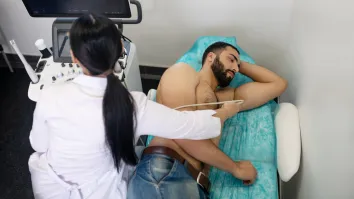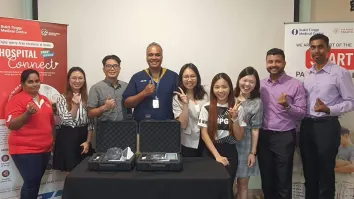Nextgen PPPs for Connected Healthcare in the Asia-Pacific
The adoption of “value” schemes to increase access to medical technologies.
In healthcare (among other social sectors), many players advocate for Public-Private Partnerships (PPPs). And with good reason – according to research conduct by KPMG and the Asia Pacific Medical Technology Association (APACMed), while the medical technology industry may contribute upwards of 5% toward a country’s GDP, healthcare expenditure allocated toward the devices is typically less than 1% of GDP. PPPs are not new in healthcare – for decades such contracting has been used to build infrastructure, and increasingly to operate critical services. However, the future of PPPs is about more sustainable whole-system financing.
Medical technology companies are already evolving their business model to become more solutionsoriented, especially in the age of IoT and connected healthcare. The time is ripe for PPP contracting to reflect the value that such innovation can deliver to a country’s health and economic strategy. Valuebased schemes have existed for some time in the pharmaceuticals space, and we can align similar dots for the medical technology ecosystem too.
“We must shift away from price-only and volumeoriented discussions, toward agreements recognizing and rewarding the value created by the industry in responding to healthcare needs,” said Yves Verboven, Director of Market Access & Economic Policies at the MedTech Europe trade association. As of 2014, EU’s Most Economically Advantageous Tendering (MEAT) Directive 2014/24 came to life and so did MedTech Europe’s framework known as MEAT Value-Based Procurement. The framework aims to equip public and private sector with the tools for a more holistic view in awarding on the value being offered, and to foster the partnership dialogs therein.
“We must embed such a ‘value’ paradigm shift into our thinking and culture, in order to unlock valuebased healthcare and to adopt it into the day-to-day practices. This includes for patients, at hospitals, in community and workplace settings, and supporting high-quality, affordable care through introduction of the MEAT concept,” Verboven continued.
MedTech Europe estimate that 70% (and growing) of medical technology related procurement is still driven based on price point, with only 2% of tenders calling for negotiated procedures and open dialog for innovative partnerships.
This article is a case study for how PPPs and“value-based” contracting schemes could work in the Asia-Pacific context. The principles are already inherent in the system: improve quality over a more cost-efficient base. Now it’s a question of how to simultaneously balance the equation, not to pivot one element against the other. This article covers: setting a care pathway vision; zooming in on market and disease focus; and configurating a proposition. We focus on Diabetes for illustration, though the concepts can apply more broadly.
Step 1: Meet stakeholders where they are today, to help provide a vision for tomorrow
Although matching various stakeholders’ timelines is always a challenge in any type of healthcare reform, ultimately the real impact is made by those who can effectively articulate a future vision that both resonates with the masses and is backed with a logical storyboard.

Diabetes, the profile in Asia of which we zoom into later, is clearly at the top of most countries’ agendas due to the growing prevalence and strain on healthcare resources. According to KPMG analysis, there is a realm of possibilities for how the Diabetes pathway and innovation could look over the next decade (see left). Diabetes also sits squarely in the conversation between prevention, chronic management, and potentially a cure.
Arriving at a PPP means an understanding that there will always be a spectrum of “value” on which the particular pathway and to-be archetype will sit. Care systems on one end are reorganizing themselves to provide higher quality service with greater cost containment. Industry companies on the other end are looking to sustain viable business model innovation. And there are a number of players in the middle that create hybrid archetypes such as virtual value. Importantly, any company or organization seeking to engage in more novel contracting must self-assess their position on the spectrum and also the position of the contracting party.
Below is a sample KPMG spectrum of archetypes and potential value models for Diabetes:

Moreover, this is where the medical technology industry diverges from what others may have experienced in “value” scheme contracting to date, such as for pharmaceuticals. As opposed to a closed system, medical technologies often pass through the regulatory process in a relatively straightforward manner, but procurement negotiations can then happen at various levels of the health system even down to the individual hospital. Health system financing can come from different buckets, such as federal and state. Fragmentation therein may cause delays in access.
“Value-based contracting schemes are already used around the world, but their appropriateness applied to the context is key,” said Verboven.
An experience cited by MedTech Europe is from Norway. Technologies like infusion catheters and needles, while of great medical importance, were purchased historically based on price and causing discomfort for patients, dissatisfaction for nursing staff, and some quality issues.
The regional procurement entity decided to change practices, and conducted a survey with patients to understand their feedback and desires. The results were shared not only within healthcare provision, but also the medical device industry, including with a dialog framework, so as to tailor the technologies, propositions, and associated value accordingly. “Such open PPP forums allow all parties to be more responsible,” said Verboven. “This gets us closer to a true value-based approach, including Total Cost of Care (TCoC) visibility which is an integral part of the equation.”
Evolving PPPs with a value focus are important on the R&D side of the medical technology industry too. University-based research that serves as an innovation arm for corporate scale-up can be a fruitful relationship. The JUMPstart joint university program in Singapore is a great example.
At five years old, JUMPstart is seeing the maturation of their portfolio studies that are converting into PPP models. Recent innovations include Flexosense, smart insole sensors to prevent ulcers for people with Diabetes (in Singapore there are four such amputations every day, in Australia it’s 12). Also NephTech, using a microphone to investigate blood vessel turbulence during hemodialysis, an endpoint for Diabetes.
The JUMPstart program is looking at real-world unmet needs, and where value can be inserted from a clinical, economic, as well as social perspective. They involve the real users (doctors, patients) directly in the research.
“We ensure that start-ups aspiring to innovate in medical technology are given the right platform to answer the value questions very early on in the development cycle,” said Dr. Bipin Bhola and Dr. Mayank Gurnani, who operate the National University Singapore side of JUMPstart. “We need the strong involvement of the private sector to guide the research and to ultimately help get the ideas into the hands of those who need it most, so from this end PPPs are important.”
The opposite effect is what MedTech Europe calls “the paradox of stagnation in innovation delivery”. In other words, there is a renaissance of medical technology coming to bear, yet insufficient funding model sustainability to keep pace. The result for some markets could be a decline in product innovation and competition.
Step 2: Zooming in on a particular market and PPP proposition
With a care pathway to-be archetype in mind and an understanding of the spectrum of value models, the next step is to get the discussions down to an actionable level. This usually means picking a particular market (even sub- market) to start. For the purposes of this article using Diabetes as an illustration, we’ve selected Australia within the Asia-Pacific context. Australia has a strong sizeable healthcare system, is open to innovation, and is already exploring novel forms of contracting for both medical services and technology. An indicative example is the “Health Care Homes” pilot program to shift toward bundled payments for regions to better manage chronic disease.
Australia, like many, faces tremendous pressures on the evolving demography of the Diabetes landscape. Prevalence has risen from 1.3% to 7% of the population over 20 years, and is expected to hit nearly 10% by 2030. Type 2 Diabetes, which represents 85% of cases, is estimated to cost AUD 14.6 billion annually, or around AUD 20 thousand per person with the condition. An additional 2.5 million people are said to be pre-Diabetic. There are also population sub-groups at higher risk, such as indigenous communities and the elderly. Countries across Asia-Pacific will recognize these dynamics.
Beyond the challenge of Diabetes prevalence is its effective management. In a study conducted in Australia, Diabetes medication adherence is around 50%, and 1 in 3 patients do not routinely rotate injection sites for insulin. As a result, half of Diabetics suffer from lipohypertrophy (skin irritation from injecting multiple times to the same location). The result is an increase in hospitalization, especially when using low quality needles.
“In many ways, Australia leads by example in global standards as it pertains to the healthcare system,” said Guillaume Sachet, KPMG Advisory Partner in Singapore. “But that doesn’t mean there aren’t opportunities for improvement. Pathways such as Diabetes, which is of high focus for the country, are ready for the public and private sectors to come together to design new innovations and financing for the future.”
Having a vision and picking a place to start is important, but a further layer deeper for a given market is to understand the structure of a country’s health system and how the decision-making works. In Diabetes there are a range of stakeholders at various care levels, social settings, and jurisdictions. The bigger question is – who owns healthcare contracting, and what are their objectives (with corresponding timelines)?
| Becton Dickinson: Beyond a supplier? Referring to the aforementioned challenge of lipohypertrophy in markets like Australia, Becton Dickinson developed a solution to support the broader healthcare ecosystem: improve injection technique for insulin. Becton Dickinson partners across the ecosystem to deliver injection technique education and training, alongside products designed to support patients to comfortably optimize their injections. Diabetes experts agree that how insulin is injected may be just as important as what is injected, in order to help manage blood glucose levels. Global studies have demonstrated that proper injection technique can significantly improve patient outcomes and lower costs. Patients who have been trained in injection technique and provided with high-quality needles have seen reduced HbA1c, lower glycemic variability, and even decreased insulin use. In Italy for example, researchers observed a 0.58% reduction in HbA1c by patients who had received lipohypertrophy education. Similarly in Russia, a randomized control trial saw a reduction in lipohypertrophy for those cohorts that went through the injection technique training. In the UK, total daily dosage fell by 5.6 units of insulin after injection technique was optimized. “The private sector can be much more than just a products supplier, especially in an increasingly connected healthcare environment,” said Caitlin Asjes, Senior Director of Government & Public Affairs for Becton Dickinson in Greater Asia, and Valerie Kwok, Director of the Diabetes Care Business Unit for Becton Dickinson ANZ. “By driving programs around injection technique in Australia, not only are we supporting public health initiatives, we are also empowering patients and their care providers. This is the future for value-based contracting models and strengthened PPP-style collaborations.” |
Step 3: Configuring (not customizing) the proposition
What emerges from the above two steps is bit of a “sweet spot” – an overlap between pressures faced by the health system with future improvement opportunity, mapped to those stakeholders responsible for designing it. The final cog is to plug in a relevant proposition.
Propositions should ideally fit within existing public sector programs, not the other way around. Fortunately in Australia as well as many countries across the region, there is already much effort underway (including specific to pathways like Diabetes) around reorganizing care models with performance-based, bundled-style funding so as to incentivize more integrated, holistic patient support.
For the private sector, this means a chance to partake in the governments’ ambitions of higher quality with greater cost-efficiency by seeking recognition of the true value that innovative medical technologies can bring to society.
“Shifting the financing base from process outcomes to value is an intermediate step for PPPs to get going, rather than dealing with so many factors that are beyond any one stakeholder’s realm of control,” said Verboven. “Win-win means sharing risk as well as sharing reward.”
“At JUMPstart, we encourage the medical technology startups to focus on value delivered across different stakeholders in order to ensure that the proposition is aligned to the entire disease pathway: payers, providers, patients, physicians, and, increasingly, policymakers,” said Dr. Bhola and Dr. Gurnani. “Understanding how the value equation of a medical technology startup’s proposition interacts with these different stakeholders is paramount towards their chances of finding success.”
We would also be remiss not to mention another key stakeholder – the patients. When we speak to patients and patient groups, it is eye-opening to see the lingering frictions in policies and pathways for critical disease areas like Diabetes. Armed with patient insights, the dialog with public sector becomes much richer.
Such a tactic also ensures we are all ultimately doing the right thing for the cohort who matters most.
“Value” type contracting models are not always a fit for the particular product/scenario, so it’s best to make the determination up front. Based on KPMG experience, we provide a simple checklist to reflect on:

Learnings to keep moving forward
Growing pains are never easy, the point is to try and learn along the way. Healthcare requires bold pioneers across the public and private sectors in order to design new models that benefit the future generations. Bringing value-based contracting concepts under a PPP format for medical technologies is the right direction.
Many people often use the data challenge as an inhibitor toward progressing along more novel “value” contracting mechanisms. Data in healthcare is and always will be a hot topic.
A few takeaways gained thus far from the initiatives, broken down by key stakeholder:
1. For industry companies: Maintain focus on the Asia-Pacific region. These are challenging markets, yet the unmet need is very high and thus novel forms of contracting can provide even greater demonstration of value.
2. For governments: Evolve healthcare services and medical technology purchasing to reward those players providing solutions to the ecosystem. Ensure proper frameworks and capabilities for assessing value.
3. For investors and other private sector constituents (e.g. telco, insurance): Get engaged in the discussion – the new wave of sustainable financing-oriented PPPs is a perfect social cause (e.g. impact bonds).
According to MedTech Europe’s experience, having the clean clinical evidence outcomes data to initiate contracting discussions is certainly one route to follow. However, they’ve seen equal advancement in starting with the pathway archetype in mind, and collecting data along the way so as to iterate the contracting experimentation and to enable the true partnership agreements.
The latter, more agile approach will lead to quicker wins in the Asia-Pacific context.
“Healthcare purchasing of services as well as medical technologies are the natural inflection point to make a real impact in value-based reform. Such an effort must be driven from bottom-up as well as at the policy level, including dedicated multistakeholder working groups in the middle to build, test, and scale.” -Yves Verboven, MedTech Europe
We hope this article will foster more proactive dialogue across the region. Health and care are among the greatest gifts to provide to a population, so we must leverage the best of our collective public-private expertise.



















 Advertise
Advertise





